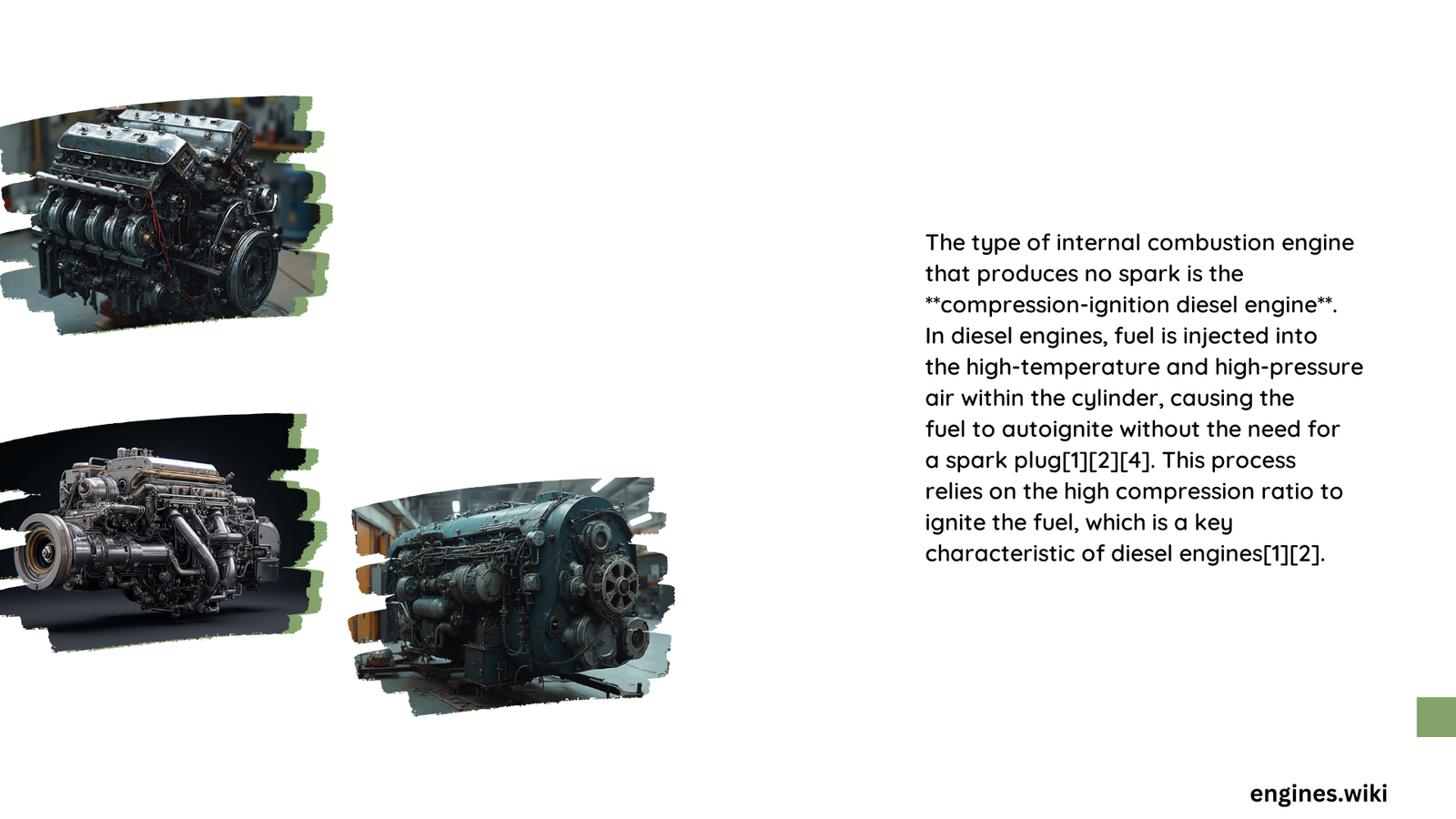The compression ignition (CI) engine, commonly known as the diesel engine, is the type of internal combustion engine that operates without a spark. This engine relies on the heat generated by compressing air to ignite the fuel, rather than using a spark plug. Diesel engines are widely used in heavy-duty vehicles, marine applications, and industrial power generation due to their efficiency and durability.
What is the Basic Principle Behind Compression Ignition Engines?
Compression ignition engines operate on a four-stroke cycle:
- Intake stroke: Air is drawn into the cylinder
- Compression stroke: Air is compressed, heating it to over 400°C
- Power stroke: Fuel is injected and ignites spontaneously due to high temperature
- Exhaust stroke: Burnt gases are expelled from the cylinder
The key difference from spark-ignition engines is the absence of a spark plug and the reliance on auto-ignition of the fuel due to high compression ratios.
How Does the Fuel Injection System Work in Diesel Engines?

The fuel injection system is crucial for the operation of diesel engines:
- Injector Types:
- Common rail injectors
-
Unit injectors
-
Injection Pressure: Often exceeding 30,000 psi
-
Timing: Fuel is injected near the top of the compression stroke
-
Atomization: High pressure ensures fine fuel droplets for efficient combustion
Modern diesel engines may use multiple injection events per cycle to optimize combustion and reduce emissions.
What Are the Key Operational Parameters of Diesel Engines?
| Parameter | Typical Range |
|---|---|
| Compression Ratio | 18:1 to 25:1 |
| Air Temperature at End of Compression | >400°C |
| Air-Fuel Ratio | 25:1 to 40:1 |
These high compression ratios and temperatures enable the auto-ignition of diesel fuel without the need for a spark.
How Do Diesel Engines Compare to Spark-Ignition Engines in Efficiency?
Diesel engines generally offer superior efficiency compared to spark-ignition engines:
- Fuel Efficiency: 20-40% improvement over gasoline engines
- Thermal Efficiency: Higher due to greater compression ratios
- Mechanical Efficiency: Up to 20-30% better, especially at part load
This efficiency advantage stems from:
1. Higher compression ratios
2. Lean burn operation
3. Reduced pumping losses
What Are the Emissions Characteristics of Diesel Engines?
Diesel engines have a complex emissions profile:
- Advantages:
- Lower carbon monoxide (CO) emissions
-
Reduced hydrocarbon (HC) emissions
-
Challenges:
- Higher nitrogen oxides (NOx) production
- Increased particulate matter (PM) emissions
Modern diesel engines employ various technologies to address these challenges:
- Exhaust Gas Recirculation (EGR)
- Selective Catalytic Reduction (SCR)
- Diesel Particulate Filters (DPF)
These systems have significantly reduced diesel engine emissions in recent years.
What Are the Main Applications of Compression Ignition Engines?
Compression ignition engines find use in various sectors:
- Transportation:
- Heavy-duty trucks
- Buses
- Marine vessels
-
Some passenger vehicles
-
Industrial:
- Construction equipment
- Agricultural machinery
-
Mining equipment
-
Power Generation:
- Standby generators
- Remote power plants
- Combined heat and power systems
The high torque output and durability of diesel engines make them ideal for these applications.
How Has Diesel Engine Technology Evolved?
Diesel engine technology has seen significant advancements:
- Fuel Injection: From mechanical pumps to electronic common rail systems
- Turbocharging: Widespread adoption for improved power density
- Materials: Use of lighter, stronger materials for engine components
- Control Systems: Sophisticated engine management units for optimized performance
- Emissions Control: Integration of advanced after-treatment systems
These developments have addressed many traditional drawbacks of diesel engines, improving their performance, efficiency, and environmental impact.
What Are the Future Prospects for Compression Ignition Engines?
The future of compression ignition engines involves several key areas:
- Alternative Fuels: Development of engines running on biodiesel, synthetic fuels, or hydrogen
- Hybridization: Integration with electric powertrains for improved efficiency
- Emissions Reduction: Continued focus on minimizing harmful exhaust gases
- Efficiency Improvements: Research into advanced combustion modes like HCCI (Homogeneous Charge Compression Ignition)
While facing challenges from electrification, compression ignition engines are likely to remain important in sectors requiring high power output and long-range capabilities.
In conclusion, compression ignition engines, which produce no spark, continue to play a vital role in many applications due to their efficiency and power output. Ongoing technological advancements are addressing their challenges, ensuring their relevance in the evolving landscape of power generation and propulsion.
References:
1. Compression Ignition: Diesel Engine & Explained – Vaia
2. Compression Ignition Engines – Revolutionary Technology That has … – Frontiers
3. Advantages of Compression Ignition Diesel Engines – SL Turbo Diesel
4. Diesel Engine – Wikipedia
